BA.2 became the majority strain in the United States this week, as expected. Mostly things are continuing as expected, with unsurprising news on a variety of fronts. The biggest surprise is that the second booster shot was approved. Given I expect to be asked about that every so often, I split that off into its own post.
Executive Summary
- BA.2 now majority strain but for now it changes nothing.
- Ultraviolet light confirmed as effective.
- Lack of federal pandemic funding having real world impacts.
- Second booster approved for those 50+ or who are immunocompromised.
Let’s run the numbers.
The Numbers
Predictions
Prediction from last week: 177k cases (unchanged) and 6,200 deaths (-12%).
Results: 189k cases (+6%) and 5,718 deaths (-18%).
Prediction for next week: 210k cases (+11%) and 5,100 deaths (-10%).
Looking back, I didn’t adjust for Colorado backfilling some deaths last week, which likely explains why there was a bigger than expected drop this week.
For next week, as BA.2 takes over I expect case growth to accelerate somewhat, but continue to not expect things to get terribly out of hand before stabilizing once again. That could still take a month or two to happen.
Deaths

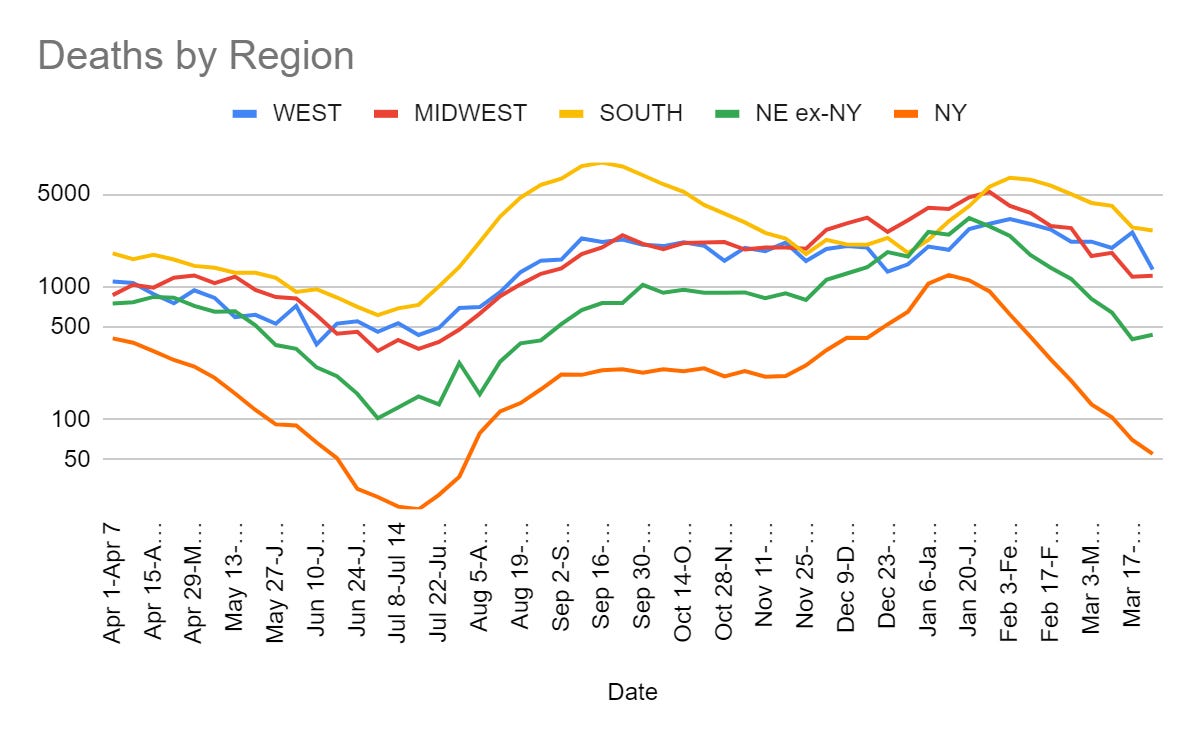
Death numbers continue to decline as previous masses of cases work their way out of the ‘counts as a Covid death’ window. The blue bump is Colorado’s backfill last week.
Cases


NYC cases, make sure to use a log scale edition. The uptick isn’t not worrying but I do not expect it to be sustained for that long, and as Zeynep says previous infections should ensure that even relatively bad scenarios do not get so bad.
BA.2 outlook, wastewater in Boston ticking up from low baseline.
In UK, ZOE study claims record high case numbers, but official numbers are dropping and well below peak. Who is right?
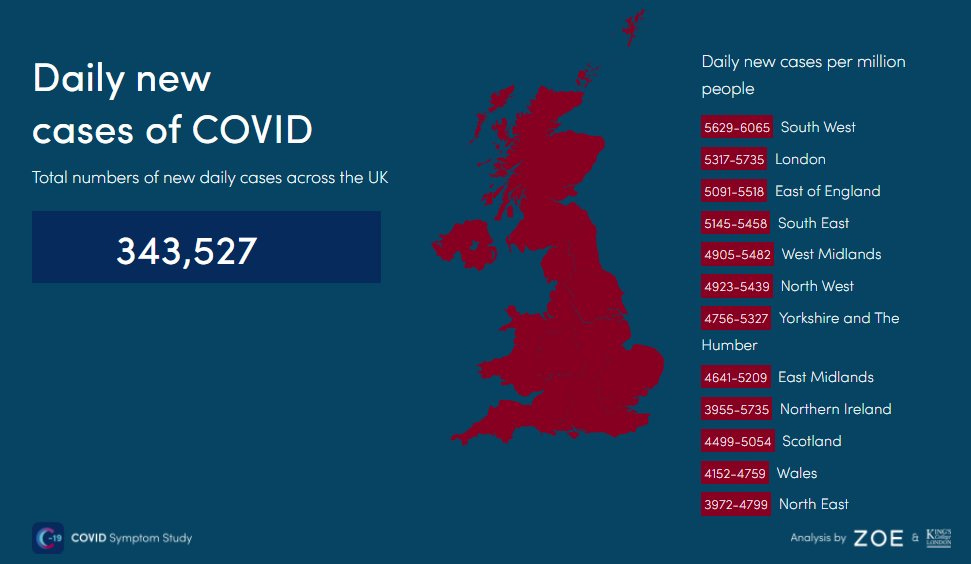
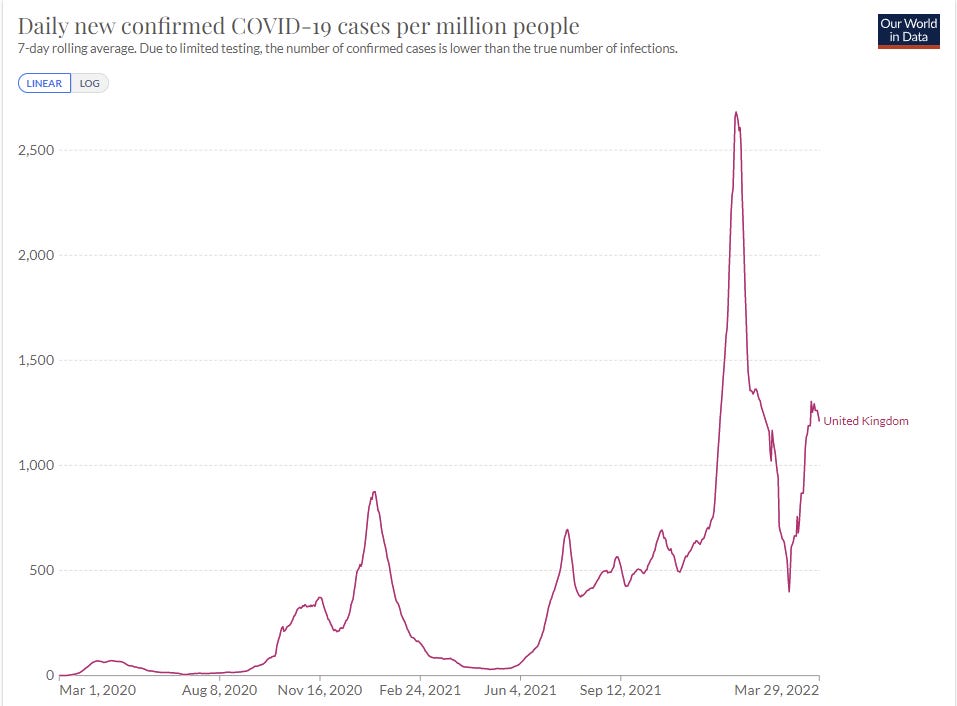
Yes, tests are down, but how much?
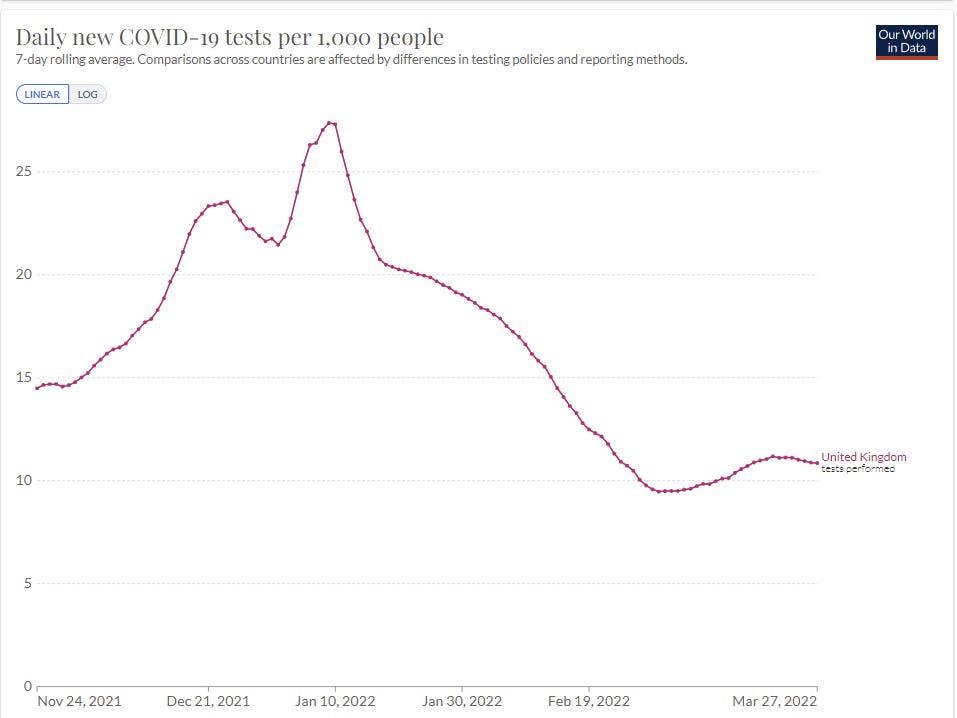
How does that translate in percentage terms?
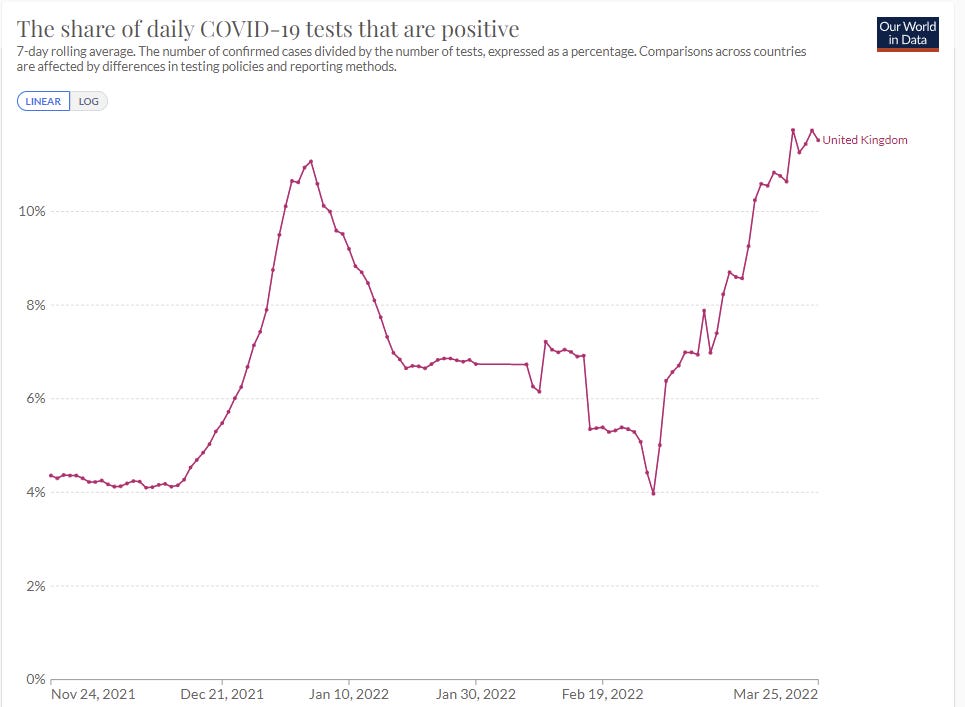
The positive test rate is slightly higher than the January peak. This implies that a somewhat smaller percentage of cases are being caught. It does not plausibly indicate that the rate of finding cases has declined by more than half.
Physical World Modeling
CDC has BA.2 becoming 55% of cases for the week ending March 29, up from 35%.
Vaccine effectiveness data for BA.2 has come in. Meet the new vaccine effectiveness, same as the old vaccine effectiveness.
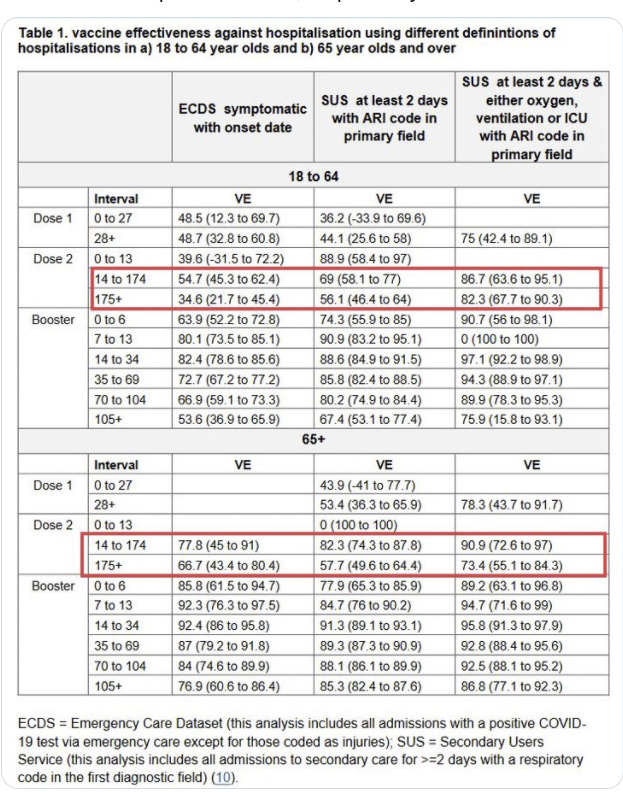
Additional new CDC vaccine efficiency data for the Omicron wave.

There is nothing here for 1 or 2 mRNA doses alone, but I’d assume 2 mRNA doses to be between 2 J&J doses and the 3-dose regimen that includes J&J.
The RECOVERY trial: A randomized controlled trial for the win. Still ongoing.
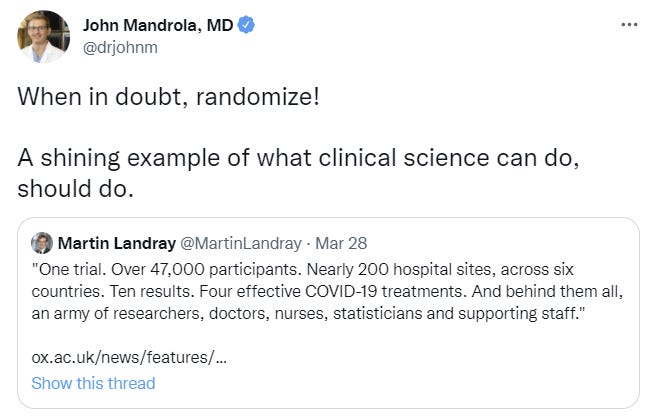

And now, a new experimental treatment is looking promising, thanks to a similar study called TOGETHER.
Last week, a clinical trial called TOGETHER produced two potentially important conclusions: A little-discussed experimental drug called peginterferon lambda cut in half the number of Covid-19 patients who ended up going to the emergency room or hospital. And the much-discussed antiparasitic drug ivermectin failed to prevent hospitalization for Covid patients at all.
TOGETHER, like the RECOVERY study conducted in the United Kingdom and REMAP-CAP, conducted basically everywhere but the United States, was a platform study, a streamlined clinical trial that evaluated multiple medicines at once and that use a common placebo group. It’s from these platform studies that doctors have learned perhaps the most about Covid-19.
…
“The only trials that have given us useful information during the pandemic have been the platform trials,” Mills told STAT in an interview, also citing the PRINCIPLE trial, which showed an inhaled steroid could reduce complications, and the PANORAMIC trial, which is starting in India.
It looks like the handful of players in the greater people-who-think-and-care-about-what-works then move-fast-and-break-things ecosystem somehow are the only ones other than major corporations who get much done anymore:
But there’s no arguing these small trials, which were comparatively inexpensive, delivered huge amounts of information. RECOVERY cost less than $10 million. Mills said the budget for TOGETHER was also $10 million. And it didn’t come from the National Institutes of Health, a big drug company, or a major charity.
Instead, one of the major funders of the trial so far has been Patrick Collison, co-founder of payments firm Stripe, who Forbes estimates to have a $9.5 billion fortune. New funds are coming from the charitable foundation FTX, a cryptocurrency exchange, and its founder Sam Bankman-Fried, who is worth $24 billion, also per Forbes.
“One of the big questions is where are the big players in this?” asked Mills. “Where is Gates Foundation? Where is NIH? Where is Wellcome Trust?”
Where are they indeed? About here.
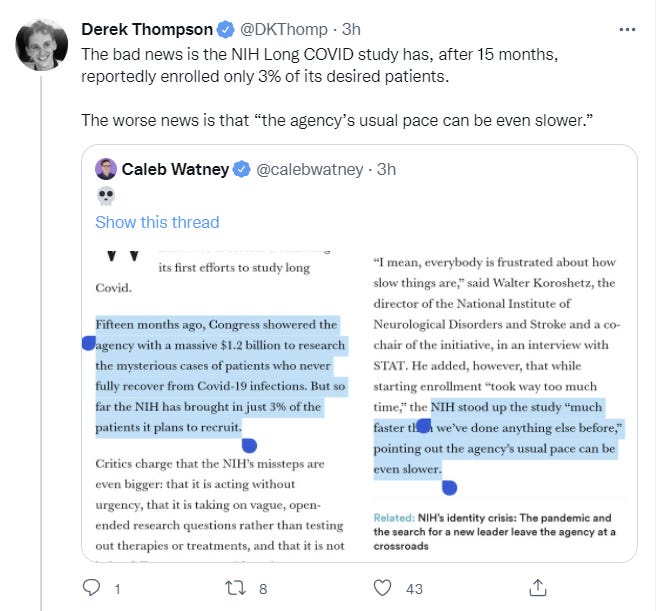
“I think pre-pandemic nobody knew how badly organized medical research is, and we assumed the esteemed investigators and big name universities or NIH would have systems in place about how to move rapidly,” Mills said. “It turns out they didn’t.”
Fluvoxamine and caffeine do not mix well. Unless you want very long lasting caffeine and damn the consequences, in which case maybe they mix awesomely? Not my area.
New Vitamin D study finds that giving people with low D concentrations Vitamin D pills does not prevent Covid, with doses tested up to 3,200 IUs a day which should have been sufficient. There was no sign of extra adverse events.
Self-reported adherence to study supplements among participants randomized to either intervention arm was good, with 90.9% of participants reporting that they took study supplements at least 6 times per week.
In the subset of participants included in the intention-to-treat analysis for whom measures of end-study vitamin D status was available, mean 25(OH)D concentrations were significantly elevated in the higher-dose vs. no offer group (102.9 vs. 66.6 nmol/L respectively; mean difference 36.3 nmol/L, 95% CI 32.9 to 39.6 nmol/L), and in the lower-dose vs. no offer group (79.4 vs. 66.6 nmol/L respectively; mean difference 12.7 nmol/L, 95% CI 9.8 to 15.6 nmol/L; Table 2, Fig. 2).
So it does look like there was at least some actual Vitamin D involved. One hypothesis they tested here is whether offering people free and convenient Vitamin D can cause people to take the Vitamin D, and the answer seems to mostly be yes. But also, even mentioning it seems like a strong intervention in terms of uptake:
On the other hand, another subset (49.9%) of participants randomized to no offer took a vitamin D supplement on one or more occasions during follow-up.
This may have led to increases in 25(OH)D concentrations in the no offer arm over the course of the study, although seasonal effects (sampling in June vs. December) will also have contributed.
This is compared to (via quick Google) 28% of Americans who take Vitamin D supplements. They note here that D concentrations did rise in the control group.
One potential hypothesis is that many or most gains are from fixing extreme deficiencies, and by testing everyone they got those with extreme deficiencies taking Vitamin D even if they were in the control group. This still does seem reasonably robust. Taking Vitamin D seems to clearly be a ‘free action’ as there were no negative effects, and there are lots of people who are deficient (e.g. Google says 42% of Americans are deficient) but this seems less urgent. I will continue to take it, but I have updated.
Bob Wachter asks what the immunocompromised should do, and notices how much his model says one can reduce their risk.


He also reminds us about Evushield, which I haven’t talked about, but which is a big help to immunocompromised people.
Look at the risk reductions here. 90%+ decline incases. 90%+ decline from masking (which seems very generous unless it’s a super-mask, but they do exist.) Additional benefit from Omicron, he says 25% and I think it’s far more than that. Then 80% or more from Paxlovid, again I think that’s on the low end. That’s three orders of magnitude, and you get another one from vaccination. There’s various light cheating involved here, but we’re talking three orders of magnitude from an at-most single-digit baseline.
Those reductions mostly also apply to everyone else.
I strongly agree with the conclusion. Things are not going to get meaningfully safer than they currently are. Life is short, especially when you are in poor health. Live it.
Doing More
Biden says do no more, or at least do not let Covid control our lives.
I agree strongly. Others disagree. They say to Do More.
Doing More. Doing More, like war, never changes.
Here’s a standardized call this week to Do More.
Here are some vaccination statistics, therefore we must do more.

That first number is pretty awesome. We got 97% of those over 50 to take the first shot. That second number is also pretty great. We got 84% fully vaccinated. I am still confused by there being far more people who declined the second shot than the first shot, but the other 16% are likely going to be impossible to get.
The third number, that only about half are boosted, is not as good. But how are you going to ensure that they get more protection? There has already been plenty of opportunity, and a lot of people do not want the third shot. I think they are making a mistake, but I see no shot at convincing them.
The fourth shot is both a lot less worthwhile than the third shot, and also where most of our remaining ‘more’ comes from at this point. Of those who are most vulnerable and who got third shots, a lot of them will presumably opt for fourth shots, and this will provide substantial additional protection for some number of months. My guess is it has about zero effect long term. Whether that is worthwhile for them is their decision, and will depend on the future path of the pandemic, but we can only do what we can do.
Here is some advice to ‘not try and time’ the fourth shot. That seems obviously silly to me. The whole idea on additional shots is a short burst of protection, and exponential growth happens over the course of weeks or months but the booster takes a week to work. So yes, absolutely it seems easy, provided the decision to get another booster at all, to usefully time one’s additional boosters. Same source also says to hold off if you’ve had Covid in the last three months, which very much seems automatic.
Biden’s budget includes over $80 billion in pandemic funding, including a 171% increase in funding for the CDC. The White House explicitly reminded us that such budgets are statements of principle, as Congress has the power of the purse. And is currently refusing to use that power on much, so it seems highly unlikely we will see very much of this money allocated. It is a dilemma when an organization like the CDC fails so utterly. Do you use this as evidence that it needs more funding, or that it has no ability to use funds well and should if anything get less? Ideally one starts over from scratch, or at least seriously reforms. I don’t see any signs of that.
Look at all the things we have shortages of when everything is fine, they say.

This makes such claims have no meaning. If we are always in shortage of such basic items no matter what, even when everything is fine, then I can’t take such complaints as having any meaning. That does not mean we aren’t in trouble if there is a ‘surge’ from BA.2, but health care would eat actual everything if given the chance.
Prevention and Prevention Prevention Prevention
White House is continuing to push air quality, a welcome development, perhaps partly motivated by their lack of funding for doing anything else while previous stimulus that mostly had nothing to do with anything health-related could be used to upgrade air filtration. Words of wisdom:
“It’s important that this becomes a passive control measure — passive in the sense that it doesn’t require people to do anything,” said Joseph Allen, director of the Healthy Buildings program at Harvard University’s T.H. Chan School of Public Health. “It’s not requiring you to wear a mask, or wear a good mask or wear it right. It’s operating in the background all the time.”
Article emphasizes the amount most of the top public health authorities actively sabotaged efforts to improve air quality by flat out denying its impact for most of the pandemic. For example:
The CDC in October 2020 first acknowledged “limited, uncommon circumstances” when people were infected with the virus through airborne transmission, particularly in enclosed spaces with inadequate ventilation. Later, in May 2021, the agency revised its guidance to emphasize that airborne transmission was a significant driver of infection.
I saw no mention of legal requirements. The last thing I want is to make it that much harder to build, and that much more expensive to live and have buildings, but we should be encouraging those with the ability to do so to improve ventilation.
In addition to air quality, another neglected front is ultraviolet light, which I have also been largely neglecting. A new paper suggests that it is highly effective at prevention (direct link), to strength previously existing evidence.

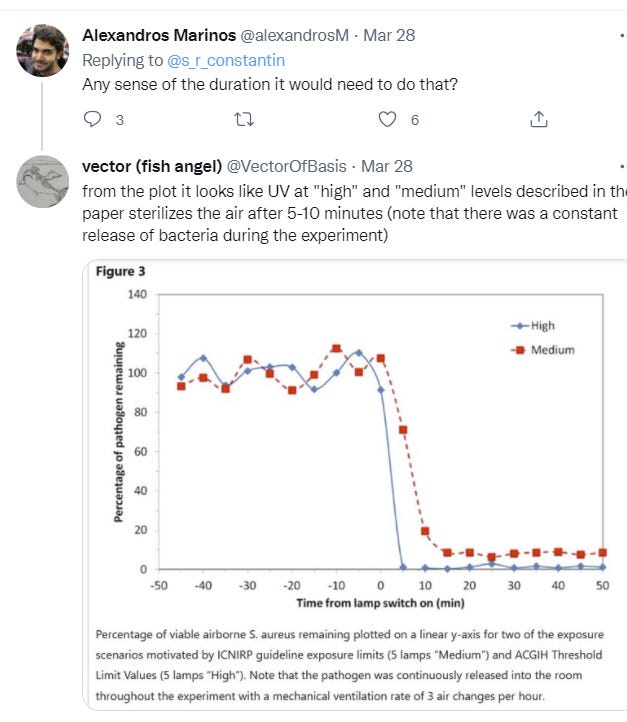
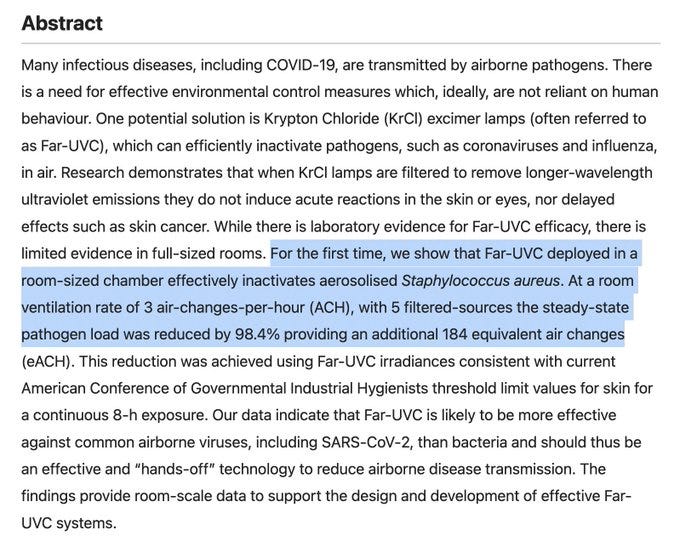
For context, this is effectively an order of magnitude improvement.

They decline to note particular commercial devices, but yes they are available. I expect almost no one to purchase them, but they are at least being used a non-zero amount (MR).
PCR tests will now cost the uninsured $125, Congress did not step in and prevent this.
Japan reaches a compromise that seems tough but fair.

China
Scott Gottlieb once again on television to point out that China is in quite the pickle. They ‘will have a hard time containing this’ he says, which is quite the understatement.
Something is wrong with OurWorldInData’s China numbers, as BNO News is reporting very different and much bigger numbers and other sources back them up. So do the numerous reports of how zero Covid no longer looks sustainable, and also various financial market moves that people are explaining as coming from the disruptions expected in China.
The new center is Shanghai, one of the world’s biggest cities. I’ve speculated that China had little spare capacity to conduct operations, and also that it was not all that committed to success like it used to be, and here we have confirmation of both (next day data link).


Shanghai is divided by a river, so they’re going to lock down the first half, test it, then lock down the second half and test there. As I remarked at the time this seems certain to be both unnecessary and insufficient. It is not part of any plan designed to achieve zero Covid. Rather, it is part of a plan that signifies the doing of things.
While the lockdown is in place it is hardcore. No one is allowed outside at all. There are robot dogs patrolling the streets. Those who want their non-robot dogs to go outside may resort to drastic measures (2 minute video).
These are flashes of the ‘do whatever it takes’ attitude, but without willingness and ability to sustain such restrictions and costs across China, it will still not be enough.
Perhaps a miracle will somehow occur. I do not expect one.
Think of the Children
Or, don’t, because you don’t have to. No news here very much is good news.
In Other News
No, seriously, no one cares about Covid anymore.

I am somewhat concerned Russia/Ukraine is not considered more urgent than this, but inflation seems like a very reasonable top concern.
Looking back on Ivermectin and its early studies.
Here is the full interview of David Redmond I asked about a few weeks ago. He is hugely overconfident, both at the time and in hindsight, but there is much wisdom in his perspective. Putting people like him in charge would be a large improvement.
“The FDA is now selling indulgences” is not fair, when over $100 million dollars is paid to get a rapid FDA decision it’s not the FDA that is selling.
Telemedicine abortion becomes permanent in UK after surprise vote. Seems great to have more permanent telemedicine available, although this seems like an ‘odd flex’ to do on its own.
In India, they are extending approval of their homegrown vaccine Corbevax to children without data to support that. More than the usual suspects are unhappy.





I do agree that ‘zero public data’ is not a sufficient amount of public data to make a decision on whether to require something. I do think it’s totally fine when deciding whether to allow something, provided we are capable of making that distinction. If parents and children want to take the vaccine without data backing it up, they should be able to make that choice, so long as everyone understands the choice being made.
I don’t know the extent to which India is capable of that.
The complaints about favoritism, regulatory capture, corruption and double standards, on the other hand, seem spot on. If you are going to have a general principle of Right to Try, and let people make their own choices, that’s great. I salute that principle. If you’re only going to do that for the political favorites, not so much.
Making this about vaccine inequality seems exactly backwards to me. This is a general pattern when addressing inequality.
- One group X has access to more and better than another group Y.
- To address this, we ban the thing group Y has access to for ‘equality.’
- Now some of group Y gets what Xs have, but most group Ys have nothing.
It would be better if everyone in the world had access to mRNA vaccines at no charge. Assuming we cannot get this first-best solution, ‘equality’ demands we be more generous allowing others to access what vaccines they can get, not less, the same way that banning ‘not good enough’ housing or child care or anything else simply means prices go up and often the poor end up going without.
We do those in need no favors, whether as individuals or as countries, by doing this. One can say ‘poorer countries deserve no worse than rich countries’ but as long as they remain poorer trade-offs will remain a thing. Also, usually imposing such restrictions hurts everyone, rich or poor. One could turn this around, and say that everyone deserves not to be physically prevented from taking life saving medicine whether they live in a poor country or a rich one.
Once again there is the issue of ‘trust.’ Once again, trust is framed as whether health experts can express trust. Nice vaccination program you have there. Shame if some health experts were to… lose trust in it. Very alarming. Better give what we ask.
Would I give this vaccine to my children if I lived in India and had no access to an mRNA vaccine? I likely would not do so without further research. I can imagine getting to the point where I thought this was net positive based on public information. I can also imagine looking and not getting there.
Not Covid
IRB Review, when do you need it?
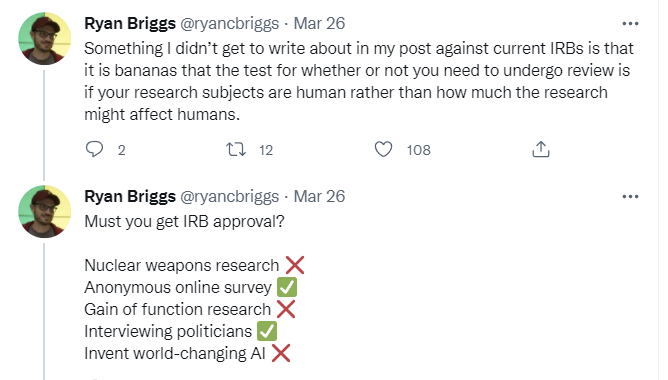

Interacting with humans is not an inherently dangerous action. Making it in the context of ‘research’ or ‘medicine’ does not make it so. Until we change this, the war on knowing things will continue.
Eliezer Yudkowsky asks, can someone actually defend frequentism for real, and make a worthwhile case that Bayesianism is meaningless?


The learning I found here is that there are a bunch of people suggesting someone else can provide a defense, but the actual provided defenses do not seem to fulfill the requirements. The search for a robust and eloquent frequentist continues.

People who got a first shot but not second, include my teenage son. I ran the numbers and figured that some protection from a first shot is worth it, but the level of cardiac side effects compared to risks of covid is too high on a second shot (and most of them show up from a second).
I know the video clearly says “David Redmond” in the beginning, but literally everywhere else on the Internet his name is spelled “David Redman”.
Put former investment bankers in charge of the Fed, and they’ll over-prioritize the health of investment banks. Put public-health officials in charge of pandemic response, and they’ll over-prioritize the health of the health-care system.
Completely ignoring emergency plans that have been worked out over the course of decades was a massively face-palm-inducing move that seemed to happen in every state and province.
I just want to log my prediction here regarding BA2. The rise will be higher in bluer, more vaccinated places than redder, less vaccinated places. Blue tribe will point to the fact that red places aren’t testing or looking for it as an explanation. This will be partially true. Red tribe will point to the fact that “natural” immunity is stronger than vaccinated immunity and that will be even more true. It doesn’t really fit anyone’s narrative that getting everyone vaccinated truly lowered deaths and hospitalizations overall but will make a population more at risk from BA2 than those communities that haven’t been as good at vaccination or PHI use.
It’s “always” been the case that the ideal situation for vaccinations was to get 90%+ of people vaccinated to drive R-actual significantly under 1 and cause COVID-19 to die out. This failed, just like all other containment mechanisms.
Red tribe culled their weak and now their tribe is stronger. Ironic given the Fundamentalist’s disdain for Darwin.
Isn’t saying that UV light might work just a euphemism for telling people to drink bleach?
Quit it with the disinformation. Bleach is useless unless you inject it directly into the lungs, which is definitely something someone 100% totally said even though nobody has any video of it.
I asked this the MR post about UVC sanitization, but assuming perfect adoption, what would the down stream effects be of removing ~98% of pathogens from indoor air supplies?
Good question. I’d be inclined to f*** around and find out.
Me too. Less colds in aggregate, but higher probability of dying conditioned on catching a cold due to less exposure over long time horizons?
Absolute effect sizes would probably be negligible but it would be interesting to ask someone who would know. Particularly if there are any of the 2% that are missed that have a possibility of mutating into something serious somewhere down the line that then infects everyone.
Outside my expertise so this is speculative, but I’d expect a big, longer term pick up in auto immune disorders. See hygiene hypothesis and kids who eat dirt being more healthy throughout life. Happy to let other people try this, but wouldn’t try it myself or recommend it to anyone I cared about. Might be great at train stations and airport though, hard to imagine short term exposures to sterile environments could be that harmful.
This may be a dumb question, but could it be analogous to not exposing kids to peanuts seeming to increase nut allergies over the long term?
I doubt that India is a good testbed to try out the principle of “right to try.” You want a population that is intelligent, educated, with access to objective information, motivated to look at it, and capable psychologically/culturally of independent thought.
India: avg IQ is ~84, 45% of children are malnourished (backed up by rates of stunting), dropped out of PISA due to abysmal scores (only its best states entered–they landed at 72 and 73 out of 74 “nations”).
It’s a nice libertarian ideal, but how many can live up to it even in the OECD? I would venture 5%. For the rest, the decision would be effectively random. I don’t think we can assume that those who don’t understand will simply say no to drugs. They understand that there is a risk; they understand that some people claim this drug will reduce that risk; they do not understand how to vet the claims and counter-claims. I’m not denying that there is a problem with sub-optimal incentives in agencies like the FDA. I suspect, however, that this solution is too strong an invitation to corruption and the abuse of the readily abused. It would be very cheap to test the understanding of this specific question in India among a random thousand parents.
Official pandemic summations are beginning to appear.
An autopsy of Swedish Covid policy:
https://www.nature.com/articles/s41599-022-01097-5
They focus heavily on the politics of Covid in Sweden.
Among the paper’s claims is that “very few elderly have been hospitalised for COVID-19” during the pandemic and many such infectees were not even examined by a doctor before their demise. The authorities ensured minimal protection in schools and cut parents out of the decision loop. The government communication strategy was very much Orwellian, reminiscent of what we’ve seen in America, but worse. For example, some agencies were caught erasing emails that had been requested through their FOIA system. They were reluctant to release relevant data to the public. Groupthink dominated in government, media, universities. One institution and a very small number of people in that institutions, perhaps just 3, had all of the effective power to set thought and policy on Covid. The political parties decided to give the bureaucrats/experts full reign and treat the pandemic as apolitical–meaning no political debate occurred, nor any criticism of policy by politicians. “In political analogy this problem with evasive accountability, autocratic governance, cover-ups and secrecy is referred to as “sovietisation” (Sörensen, 2020).”
The authorial perspective is uncritical internationalism. The major problem with the paper is that they implicitly consider the WHO an unimpeachable public health authority and deviation from WHO guidelines as malpractice by definition. They haven’t been paying close attention here. Another place they go off the rails is in accusing the Swedish public of supporting a “Social Darwinism philosophy,” since they supported the overall Swedish pandemic response, and supposedly this response resulted in higher mortality for immigrants and the poor than a proper internationalist response. This comes after they accuse the thought control institutions of delivering homogeneous, inaccurate Covid info to the populace. The irony is lost on them. They castigate the people for succumbing to national propaganda even while they treat international propaganda as Objective Spirit. And why should incompetent internationalism be preferred to incompetent provincialism?
They never mention this: Though the Swedish authorities made many mistakes, Sweden has had less excess mortality (0.15%) than all but 4 other European countries (Norway, Denmark, Finland, Ireland–which average 35% lower mortality than Sweden). They note triumphantly that the OECD and the EU rated Sweden lowest in Covid management of 35 European countries. Again, they don’t mention that these judgments were rendered despite Sweden having the fifth lowest mortality in Europe and one-sixth the mortality of Bulgaria.
On the whole, one could hope for a more professional and objective autopsy, but some of Sweden’s political pathologies are real.
What do you make of the new variant with a thiotimolinase active site (https://en.wikipedia.org/wiki/Thiotimoline) ? On the one hand, with a generation time about a week shorter than that of omicron, whatever peak it produces will be tall, lots of people recovering from and then catching the variant at the same time. On the other hand, the very fact that this variant recently went extinct suggests that it’s outcompeted by omicron.
Unusually, the variant’s endochronicity should allow direct measurement of the total number of cases yet to occur if we can only find a way to distinguish the pre-infection immunity caused by this variant from the immunity caused by the others (and vaccines) — and if humanity gets on the ball reasonably quickly, it should be possible to track this variant into the immediate vicinity of patient zero.
I wish you a silly April 1st!
Quick note on the UK; I think the UK is likely at or above previous record case levels.
In my view the best (albeit lagged) UK data source by far is the ONS infection survey, because it has a large longstanding randomly-selected sample of households and just tests each household once per month. Results from tests taken 5-12 days ago are then published every Friday.
The most recent data, for tests done 20th-26th March, came out this 1st April, and shows the highest % of positives ever seen.
(So why has the official case detection rate fallen so much? I don’t know for sure, but I’m not sure it matters; testing the same randomly-chosen group over and over seems like it has way fewer confounders.)
https://www.ons.gov.uk/peoplepopulationandcommunity/healthandsocialcare/conditionsanddiseases/bulletins/coronaviruscovid19infectionsurveypilot/1april2022
Vitamin D: The study discussed in the post is fine for what it is I guess, but I don’t find it a reason to update at all.
My understanding of the Vitamin D literature is that it has been about *outcomes* the whole time.
Clinically Low Vit D levels = Bad Covid Outcomes
Good Vit D levels = Better Covid Outcomes
Raising someone’s Vit D levels from clinically low to good *prior to infection* will improve their odds of a good covid outcome significantly (and many other health issues besides)
I thought the idea that “vitamin D prevents covid infection” was long since put to bed, I guess this study puts another nail in that.
Air/UV: At the risk of failing to do good by trying to do perfect: Shouldn’t we combine the air filtering interventions and the UV interventions at the same time?
It seems obviously easy and right to just install the far-UV light with the improved air filtering inside the ventilation system….which is why I find the robot from the airport picture so confusing.
If you’re going to install UV inside the ventilation system, you don’t need to make it the far-UV, whose advantage is that it’s human safe on account of having next to no penetrating power. Ordinary UV will kill viruses, too, the only issue with it is that it can give you sunburn.
https://mobile.twitter.com/meganranney/status/1508777765801275396
Everything is not fine! Some things on the list in the tweet are staffing shortages, and many of the drugs/medical supplies things are very likely due to staffing problems at the manufacturers. It is a big problem that so many people don’t want to work anymore and things like a shortage of “kindness from pts” are a big part of it.
meganranney wrote:
“An incomplete list of things currently in short supply at hospitals:
* 20 gauge IVs
* lidocaine with epi
* normal saline bags
* dextrose 50g
* ekg paper
* nurses
* nurses’ aides
* staffed beds
* kindness from pts
* ability to care for pts as they deserve”
TheZvi wrote:
“Look at all the things we have shortages of when everything is fine, they say.
This makes such claims have no meaning. If we are always in shortage of such basic items no matter what, even when everything is fine, then I can’t take such complaints as having any meaning”
I understood “everything is fine” as meaning that there isn’t an unusually high demand for healthcare right now. Luckily, the the items in the tweet are listed in groups:
– IV lines through EKG paper: commodity materials. These are so cheap that there should always be a plentiful supply of them, for multiple reasons, ranging from “wasting some of these can reduce the friction in nurses’ work” to “having a stockpile for low-probability mass casualty events”. If there is a shortage of these under conditions as benign as they are currently, we can infer some kind of systemic failure. Regulations make it difficult to increase supply, hospitals are incentivized to not keep any stock, etc. More money would not help solve the problem.
– Nurses, aides, staffed beds: this is a single item repeated three times. This item (trained labor for occasionally disgusting work) is expensive even under sane circumstances, so I would be willing to give it a pass if it were possible to train a lot more people into these jobs (or at least the easiest-to-teach part of them, so that full nurses could concentrate on the parts not easily teachable) if the necessity became visible. I’d grant that, as Western Civilization, our policy is to adjust the supply to anticipated demand, and this is reasonable since maintaining “excess” supply is expensive. Alas, as far as I know this wasn’t done basically anywhere despite there being several waves — places like Belgium called in people from the army after they realized they ran out of capacity in their late 2020 wave, but didn’t prepare for this contingency before it hit. Again our policy is not sane, in a way that mostly isn’t a function of insufficient money.
– Kindness from patients: mostly not a thing that can be bought with money, therefore not an argument for more funding. This is mostly a request for culture to ascribe higher status to nurses.
– Ability to care for patients as they deserve: an explicitly moral claim, one which always adjusts to whatever level is aspirationally available.
I agree there is a systemic failure, or several systemic failures in the entire healthcare industry, from manufacturing to insurance to patient care. Surely it would be absurd to claim all we need is even more funding. There is no workable way to fix it. It will keep getting worse until there is a catastrophic collapse. There will be many casualties and ruined lives. Given the state of everything, “Everything is fine” is a bizarre way to say we are not currently in a pandemic wave.
The numbers for China from Our World in Data used to be low, but they seem to be good now (with the exception of the single most recent day, which consistently seems to be low for some reason).
The number of people who got at least once dose is overcounted, and the number of people who got a second dose or booster is undercounted, due to issues with matching people to themselves if they get their second dose/booster in a different jurisdiction or from a different provider:
“To protect the privacy of vaccine recipients, CDC receives data without any personally identifiable information (de-identified data) about vaccine doses. Each record of a dose has a unique person identifier. Each jurisdiction or provider uses a unique person identifier to link records within their own systems. However, CDC cannot use the unique person identifier to identify individual people by name. If a person received doses in more than one jurisdiction or at different providers within the same jurisdiction, they could receive different unique person identifiers for different doses. CDC may not be able to link multiple unique person identifiers for different jurisdictions or providers to a single person.”
https://covid.cdc.gov/covid-data-tracker/#vaccinations_vacc-total-admin-rate-total
Wrt. Japan, it is worthwhile noticing the (likely absent in Western media) fact, that it currently occupies the very low, 151th place in the Covid deaths per 1M population stats per Worldometers, with _zero_ formal restrictions on regular people since the beginning of pandemic, and only some occasional restrictions on restaurants (no alcohol, closures at 8pm, enforcement not clear either). Schools reopened in June 2020 and have been continuously operating since. This combination keeps feeling impressive.